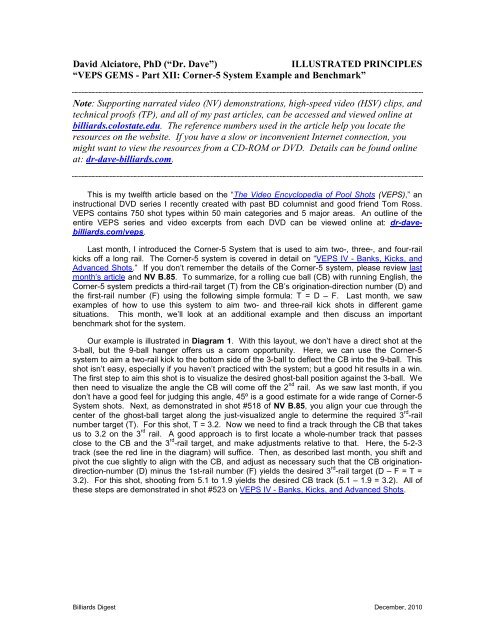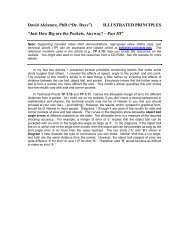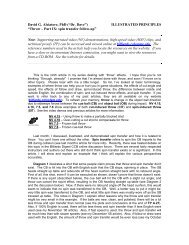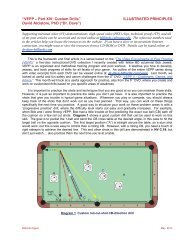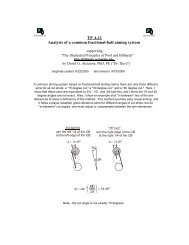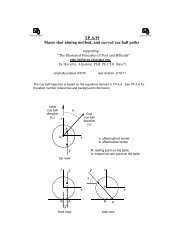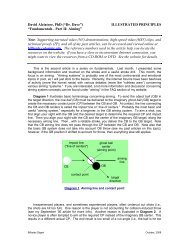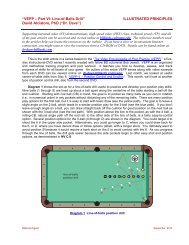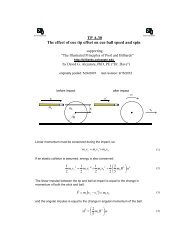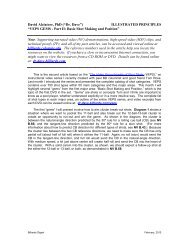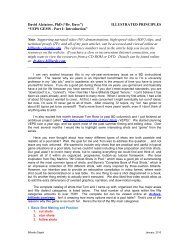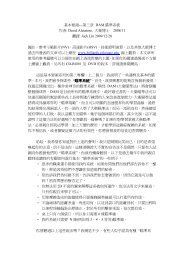VEPS GEMS - Part XII: Corner-5 System Example and Benchmark
VEPS GEMS - Part XII: Corner-5 System Example and Benchmark
VEPS GEMS - Part XII: Corner-5 System Example and Benchmark
Create successful ePaper yourself
Turn your PDF publications into a flip-book with our unique Google optimized e-Paper software.
David Alciatore, PhD (“Dr. Dave”) ILLUSTRATED PRINCIPLES<br />
“<strong>VEPS</strong> <strong>GEMS</strong> - <strong>Part</strong> <strong>XII</strong>: <strong>Corner</strong>-5 <strong>System</strong> <strong>Example</strong> <strong>and</strong> <strong>Benchmark</strong>”<br />
Note: Supporting narrated video (NV) demonstrations, high-speed video (HSV) clips, <strong>and</strong><br />
technical proofs (TP), <strong>and</strong> all of my past articles, can be accessed <strong>and</strong> viewed online at<br />
billiards.colostate.edu. The reference numbers used in the article help you locate the<br />
resources on the website. If you have a slow or inconvenient Internet connection, you<br />
might want to view the resources from a CD-ROM or DVD. Details can be found online<br />
at: dr-dave-billiards.com.<br />
This is my twelfth article based on the “The Video Encyclopedia of Pool Shots (<strong>VEPS</strong>),” an<br />
instructional DVD series I recently created with past BD columnist <strong>and</strong> good friend Tom Ross.<br />
<strong>VEPS</strong> contains 750 shot types within 50 main categories <strong>and</strong> 5 major areas. An outline of the<br />
entire <strong>VEPS</strong> series <strong>and</strong> video excerpts from each DVD can be viewed online at: dr-davebilliards.com/veps.<br />
Last month, I introduced the <strong>Corner</strong>-5 <strong>System</strong> that is used to aim two-, three-, <strong>and</strong> four-rail<br />
kicks off a long rail. The <strong>Corner</strong>-5 system is covered in detail on “<strong>VEPS</strong> IV - Banks, Kicks, <strong>and</strong><br />
Advanced Shots.” If you don’t remember the details of the <strong>Corner</strong>-5 system, please review last<br />
month’s article <strong>and</strong> NV B.85. To summarize, for a rolling cue ball (CB) with running English, the<br />
<strong>Corner</strong>-5 system predicts a third-rail target (T) from the CB’s origination-direction number (D) <strong>and</strong><br />
the first-rail number (F) using the following simple formula: T = D – F. Last month, we saw<br />
examples of how to use this system to aim two- <strong>and</strong> three-rail kick shots in different game<br />
situations. This month, we’ll look at an additional example <strong>and</strong> then discuss an important<br />
benchmark shot for the system.<br />
Our example is illustrated in Diagram 1. With this layout, we don’t have a direct shot at the<br />
3-ball, but the 9-ball hanger offers us a carom opportunity. Here, we can use the <strong>Corner</strong>-5<br />
system to aim a two-rail kick to the bottom side of the 3-ball to deflect the CB into the 9-ball. This<br />
shot isn’t easy, especially if you haven’t practiced with the system; but a good hit results in a win.<br />
The first step to aim this shot is to visualize the desired ghost-ball position against the 3-ball. We<br />
then need to visualize the angle the CB will come off the 2 nd rail. As we saw last month, if you<br />
don’t have a good feel for judging this angle, 45º is a good estimate for a wide range of <strong>Corner</strong>-5<br />
<strong>System</strong> shots. Next, as demonstrated in shot #518 of NV B.85, you align your cue through the<br />
center of the ghost-ball target along the just-visualized angle to determine the required 3 rd -rail<br />
number target (T). For this shot, T = 3.2. Now we need to find a track through the CB that takes<br />
us to 3.2 on the 3 rd rail. A good approach is to first locate a whole-number track that passes<br />
close to the CB <strong>and</strong> the 3 rd -rail target, <strong>and</strong> make adjustments relative to that. Here, the 5-2-3<br />
track (see the red line in the diagram) will suffice. Then, as described last month, you shift <strong>and</strong><br />
pivot the cue slightly to align with the CB, <strong>and</strong> adjust as necessary such that the CB originationdirection-number<br />
(D) minus the 1st-rail number (F) yields the desired 3 rd -rail target (D – F = T =<br />
3.2). For this shot, shooting from 5.1 to 1.9 yields the desired CB track (5.1 – 1.9 = 3.2). All of<br />
these steps are demonstrated in shot #523 on <strong>VEPS</strong> IV - Banks, Kicks, <strong>and</strong> Advanced Shots.<br />
Billiards Digest December, 2010
5.1<br />
CB Originating Direction (D)<br />
6<br />
7<br />
8<br />
5<br />
4.5 4 3.5 3<br />
7<br />
rolling CB<br />
with running<br />
English<br />
7<br />
5-to-2<br />
6<br />
T = D - F<br />
3.2 = 5.1 - 1.9<br />
6<br />
5<br />
5<br />
Billiards Digest December, 2010<br />
4<br />
4<br />
3.2<br />
Third Rail Number (T)<br />
4<br />
6<br />
8<br />
3<br />
3<br />
First Rail Number (F)<br />
Diagram 1 <strong>Corner</strong>-5 two-rail kick billiard<br />
2<br />
2<br />
1.9<br />
1<br />
assumed<br />
direction off<br />
2nd rail<br />
45º<br />
Diagram 2 illustrates an important benchmark for using the <strong>Corner</strong>-5 system for three- <strong>and</strong><br />
four-rail kick shots. It consists of a three-rail kick from the corner pocket to the cross-corner<br />
pocket on the same short rail. For a billiard table that plays “on system,” the 5-to-3 track (D=5,<br />
F=3) goes through 2 on the third rail (T = 5 – 3 = 2) <strong>and</strong> proceeds to the target corner pocket, per<br />
the blue path. On most pool tables, however, a track closer to 5-to-2 heads to the same corner<br />
pocket off the third rail (see shot #519 in NV B.85). It is useful to know which particular 3 rd -rail<br />
target results in a path to the corner on the table you happen to be playing on. On my table, the<br />
target is 3 (5 – 2 = 3), but on yours it might be different (e.g., 3.2). To find the benchmark 3 rd -rail<br />
target on your table, start with the 5-to-2 track <strong>and</strong> make adjustments, if necessary, from there. If<br />
the CB comes up short of the pocket (on the long-rail side), decrease the 1 st -rail number a little;<br />
<strong>and</strong> if the CB goes long (on the short-rail side), increase the 1 st -rail number. Even though the<br />
path off the 3 rd rail will vary with the type of table <strong>and</strong> conditions, the <strong>Corner</strong>-5 <strong>System</strong> formula<br />
should still be fairly accurate <strong>and</strong> consistent. For example, in Diagram 2, even though the two<br />
tracks to the corner are quite different, the formula still holds for both: 5-3=2 <strong>and</strong> 5-2=3. Again,<br />
the system generally does a good job of predicting the 3 rd -rail target.<br />
1<br />
3<br />
9
6<br />
7<br />
8<br />
5<br />
4.5 4 3.5 3<br />
7<br />
7<br />
6<br />
6<br />
5<br />
3 = 5 - 2<br />
5<br />
Billiards Digest December, 2010<br />
4<br />
4<br />
3<br />
typical<br />
billiard-table<br />
benchmark track<br />
Diagram 2 <strong>Corner</strong>-5 <strong>System</strong> benchmark track<br />
3<br />
2<br />
2<br />
1<br />
typical<br />
pool-table<br />
benchmark track<br />
Knowing which 3rd-rail diamond sends the CB to the corner pocket allows us to target the<br />
corner pocket from different positions on the table. As shown in Diagram 3, the tracks from 6 to<br />
3 (6 – 3 = 3), 5 to 2 (5 – 2 = 3), 4.5 to 1.5 (4.5 – 1.5 = 3), <strong>and</strong> 4 to 1 (4 – 1 = 3) all go through our<br />
benchmark reference (3) on the 3rd rail <strong>and</strong> continue to the corner pocket. These tracks <strong>and</strong><br />
several related examples are demonstrated in shots #520 <strong>and</strong> #522 of NV B.85. Again, any track<br />
through our 3 rd -rail reference is predicted to head to the corner.<br />
1
6<br />
7<br />
8<br />
5<br />
5 - 2 = 3<br />
4.5 4 3.5 3<br />
7<br />
6<br />
5<br />
4.5 - 1.5 = 3 4 - 1 = 3<br />
6 - 3 = 3<br />
7<br />
6<br />
5<br />
Diagram 3 Tracks to the corner from benchmark 3 rd -rail number<br />
Now that we know how to get to the corner pocket, let’s look at how we can execute shifts<br />
relative to the benchmark to target balls on either side of it. For example, to pocket the 2-ball in<br />
Diagram 4, while shooting from 5, we need to decrease the 3 rd -rail number by one to send the<br />
CB one diamond short of the pocket. This is accomplished simply by increasing the 1 st -rail<br />
number by one, relative to our benchmark. That is, our 3rd rail target is now 2, thus we aim at 3<br />
on the 1 st rail (5 – 3 = 2). To pocket the 4-ball instead, we need to increase the 3 rd -rail number by<br />
one to send the CB one diamond long of the pocket. This is accomplished by decreasing the 1 st -<br />
rail number by one, relative to our benchmark. Therefore, we aim at 1 on the 1 st rail to target 4 on<br />
the 3 rd rail (5 – 1 = 4). Both of these shots are demonstrated in shot #521 of NV B.85.<br />
Billiards Digest December, 2010<br />
4<br />
4<br />
3<br />
3<br />
2<br />
2<br />
1<br />
1
6<br />
7<br />
8<br />
5<br />
4<br />
4.5 4 3.5 3<br />
7<br />
7<br />
2<br />
Diagram 4<br />
6<br />
6<br />
5<br />
4 = 5 - 1<br />
5<br />
Billiards Digest December, 2010<br />
4<br />
4<br />
Shift relative to <strong>Corner</strong>-5 benchmark track<br />
3<br />
3<br />
2<br />
2<br />
1<br />
2 = 5 - 3<br />
<strong>Example</strong> shots from the fourth <strong>VEPS</strong> DVD, including the ones discussed in this article, can<br />
be viewed on the <strong>VEPS</strong> website or at billiards.colostate.edu under NV B.81 through NV B.86.<br />
normal video<br />
NV B.81 – Bank <strong>and</strong> kick shot terminology <strong>and</strong> basics, from <strong>VEPS</strong> IV<br />
NV B.82 – Rolling-cue-ball through-diamond kick-shot aiming system, from<br />
<strong>VEPS</strong> IV<br />
NV B.83 – Shallow-angle contact-point-mirror-image kick-shot aiming system,<br />
from <strong>VEPS</strong> IV<br />
NV B.84 – Plus <strong>System</strong> for aiming two-rail kick shots, from <strong>VEPS</strong> IV<br />
NV B.85 – <strong>Corner</strong>-Five <strong>System</strong> for aiming three-rail kick shots, from <strong>VEPS</strong> IV<br />
NV B.86 – Cut-induced throw (CIT) <strong>and</strong> spin-induced throw (SIT), from <strong>VEPS</strong> IV<br />
I hope you are enjoying <strong>and</strong> benefiting from my series of articles featuring shots from the<br />
“Video Encyclopedia of Pool Shots (<strong>VEPS</strong>).” Have you been practicing the <strong>Corner</strong>-5 <strong>System</strong>? If<br />
so, you may have noticed that the system does not work equally well over a full range of CB<br />
positions <strong>and</strong> shot angles. Next month, we’ll look at how to improve the effectiveness of the<br />
system.<br />
Good luck with your game,<br />
Dr. Dave<br />
PS:<br />
• I know other authors <strong>and</strong> I tend to use lots of terminology (e.g., squirt, throw, stun, ball-hit<br />
fraction, etc.), <strong>and</strong> I know not all readers are totally familiar with these terms. If you ever<br />
come across a word or phrase you don’t fully underst<strong>and</strong>, please refer to the online<br />
glossary on my website.<br />
1
• I want to thank Jim Valasina. He graciously proof-reads my articles every month to help<br />
find errors <strong>and</strong> make suggestions. My article quality is better as a result of his efforts.<br />
Thanks again Jim!<br />
Dr. Dave is author of the book, DVD, <strong>and</strong> CD-ROM: “The Illustrated Principles of Pool<br />
<strong>and</strong> Billiards,” the DVD Series: “The Video Encyclopedia of Pool Shots,” <strong>and</strong> the DVD:<br />
“High-speed Video Magic.”<br />
Billiards Digest December, 2010


